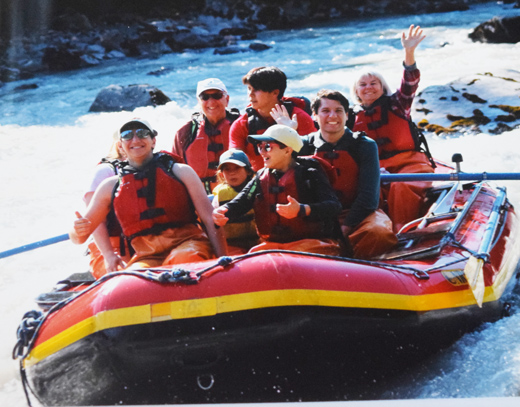
By Donald H. Harrison
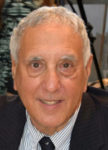
JUNEAU, Alaska – Getting ready for rafting down the Mendenhall River is almost as exciting as the ride itself.
“T,” a guide for Alaska Travel Adventures who says his Japanese name sometimes is too difficult for western tongues to pronounce, had our eight family members pull rubber trousers over our clothes, switch our footwear for tall rubber boots, and then strap on life jackets before he would let us get into the raft.
To board the beached raft, we were instructed to park our butts onto the end of one of its benches, then swing our legs, one at a time, over the raft’s rim. Next, we were told to slide down the bench to make room for the next entrant.
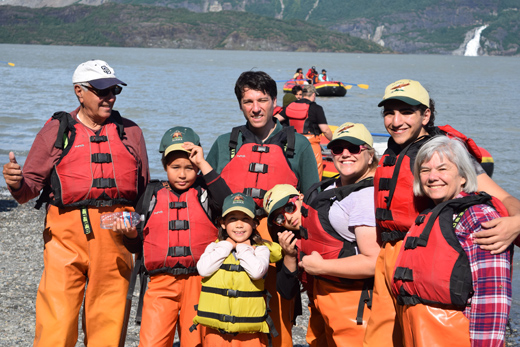
Once we were safely aboard, T instructed us on how we greenhorns would be able to assist him while navigating the raft over the fairly gentle rapids. If you have ever pushed a beach ball under the water, you know that it will pop right back up. Rafts have similar buoyancy. In certain parts of the river, to lift the raft while crossing some treacherous rocks, our eight family members, along with T, bounced in unison up and down, causing not a little bit of excitement.
While T hadn’t had any passengers spill out of his raft – yet!—he told us that in the event someone did fall into the ice cold river, there were certain procedures to follow. If someone fell near the shore and could make it to dry land on his or her own power, that’s what he or she ought to do. Otherwise, he or she should try to stay upriver of the raft, and float with toes and chin pointed upward toward the sky. T promised that in such an event he would throw a rope to us, by which we might pull ourselves in. Around the raft was a guide rope onto which we could grasp until being pulled to safety.
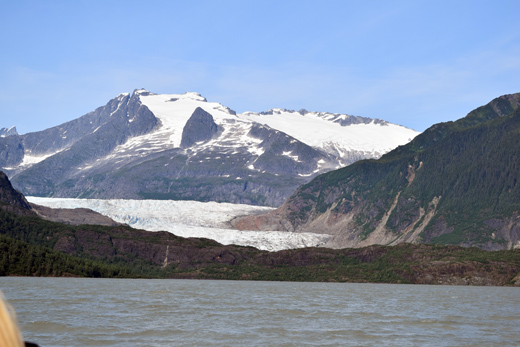
T cautioned us that the water was so cold that we could suffer severe hypothermia if we spent as much as 15 minutes in it.
Nancy and I brought our 40ish children Sandi and David on the trip, along with their children (our grandchildren). Sandi’s children are Shor, 18, and Sky, 12. David’s are Brian, 10, and Sara, 8.
The seriousness with which T delivered our instructions seemed to have temporarily unnerved Sky, Brian, and Sara, with more than one of them holding tightly onto the edges of their seats during the initial portions of the ride.
However, most of the excursion, which from start to finish including land transportation lasted 3 ½ hours, was a gentle float down the river. Soon the three youngsters felt confident enough – with adults besides them – to relax their grips and to enjoy the scenery.
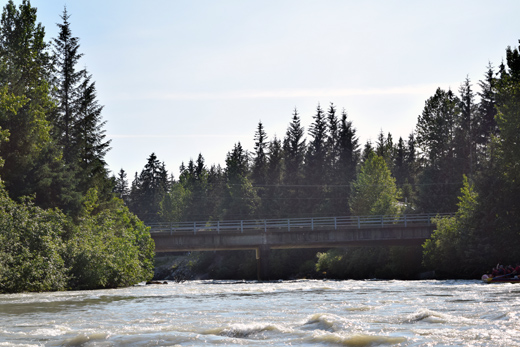
When we traversed rapids, we all hooted and hollered, possibly making a bigger deal about the experience than it may have deserved. But the Alaskan outdoors seems to prompt a certain exuberance. If homeowners sitting in their back yards along the banks of the Mendenhall thought we were overdoing it a bit, they were kind enough to just smile, wave at us, and to say nothing. Alaskans are really nice that way.
*
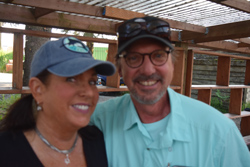
We got to know Dale Smith and his wife, the former Stacy Steinzeig, at the Gold Creek Salmon Bake after our rafting trip. Alaska Travel Adventures, the company for which Smith serves as director of marketing, operates both attractions, as well as kayaking, whale watching, and other Juneau-based adventures. The company also offers outdoor activities in Ketchikan, Sitka, Skagway, and Anchorage.
Originally from Kansas City, Missouri, the Smiths decided after ten years there publishing Paw Prints The Magazine, featuring news and animal interest stories for pet owners, that they’d like to do something different. Dale sent resumes to publications in numerous small-town markets, eventually accepting an editorial job with Capital City Weekly in Juneau. But like many newspapers, the weekly had difficulty making revenues exceed expenses. It eventually was merged with a daily newspaper, and Dale was soon out looking for a new job. The two biggest employment sectors in Juneau are government and tourism. Dale found work as the marketing director for Alaska Travel Adventures’ Juneau properties, eventually rising in the organization to direct the marketing for all properties in Alaska. Stacy worked for six years as a marketing representative for the Southeast Alaska Regional Health Consortium. Today, she is an independent marketing consultant.
I asked if the great outdoors was one of the reasons why the couple was attracted to Alaska.
Dale said it definitely was for him; he likes to kayak and hike, even though the hiking typically is up some pretty rugged, glacier-carved mountain terrain. Stacy said while she likes kayaking, vigorous hiking and other strenuous outdoor activities have zero appeal for her. “Our people wandered 40 years in the desert; we (Jews) don’t like that anymore,” she quipped.
Dale grew up in a nominally Christian family that traces its roots back to American colonial days. Dale’s direct ancestors fought in both the Revolutionary War and the Civil War. The intermarried couple said they tend more toward Judaism than Christianity, although they do have a Christmas tree in their home on nearby Douglas Island. They also each light a channukiah during the eight-day winter celebration. Dale particularly enjoys ending the traditional barucha for kindling the lights with a hearty “Shel Chanukah!”
Isn’t it awfully cold in Alaska during the winter? I wondered.
“The winters aren’t as bad here as they were in the Middle West,” Stacy declared.
“They are worse in Kansas City,” Dale affirmed. “Here in Southeastern Alaska we are on the ocean. This is really a temperate rain forest.”
Nevertheless, the tourist season in Alaska only lasts the five months that the cruise ship industry brings people up to Alaska, typically the three months of summer and a month shoulder season on either side of summer. The sun during that time of year stays up 18 hours a day, which makes for very long working hours for entrepreneurs in the tourist industry.
Dale told me that even during the season, tourism can be adversely affected by the weather. “For example, today anything that was going on at the lake was cancelled due to a phenomenon called ‘katabatic winds.’ As winds rush down off the glacier, and as air heats up on the lake, it causes a void, so that the winds can sometimes reach 50 to 60 miles an hour. That makes it too dangerous to take a kayak out, so we had to cancel.”
Until recently, Southeastern Alaska was experiencing a drought, and up to about three weeks ago, “there wasn’t enough water in the river” to make our rafting adventure feasible, Dale said.
On our rafting trip, as we passed a number of uprooted trees lying by the side of the river, our guide T had told us about another phenomenon known as a jökulhlaup during which melting snow from the glacier will cause the river to rise approximately two feet, producing currents strong enough to pull trees by their roots from the riverbank.
Changes in weather also can cause cancellation of whale watching, Dale told me. “You can get high winds at sea too; and the last thing we would want is for people to get seasick on a whale watching adventure.”
Two kinds of whales are most often seen off the coast of southeastern Alaska. Summer time is feeding season for the Humpback Whales, which eventually will migrate to Hawaii for their breeding season. Juneau also has two pods of Orcas, which Dale distinguishes as the “good guys and the bad guys.” The resident pod of Orcas feeds on salmon, but the transient pod prefers sea mammals. They will attack baby Humpbacks as well as seals, sea lions and “anything else they can find,” Dale noted.
*
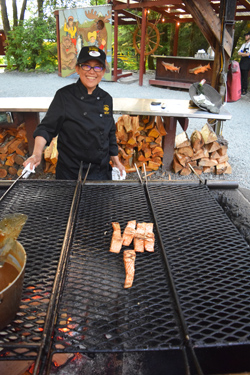
Much like the Orcas of the resident pod, tourists are attracted to the salmon of Alaska. At the Gold Creek Salmon Bake, we got to taste wild salmon, caught in Alask, cooked over an outdoor fire, and slathered in a brown sugar glaze.
Along with the salmon came a variety of side dishes including a spicy couscous salad, a salmon Caesar salad, coleslaw, au gratin potatoes, wild rice pilaf, baked beans, and corn bread. There was also blueberry cake for dessert. My daughter Sandi Masori, who is food critic for San Diego Jewish World, will have a column about that in our July 8 issue, so I won’t venture further into her territory, except to say that the dinner was delicious.
Stacy told us that she and Dale will eat only wild salmon, never the salmon raised in captivity. She said she believes those raised in captivity neither taste as good, nor are as healthy, as those caught swimming upstream in Alaska’s rivers.
The Gold Creek Salmon Bake is on property that was once owned by late 19th Century Alaska Gold Rush prospector John Wagner, who had both a mine claim and a homestead alongside a medium sized waterfall.
“The entire hillside back here is nothing but mine shafts, so you don’t want to get off the main trail,” Dale advised.
Near the waterfall, there is a trough of water and some pans for tourists to try their luck panning for gold. With plenty of light left in the evening sky, that’s a pleasant way to work off a fine dinner!
*
Harrison is editor of San Diego Jewish World. He may be contacted via donald.harrison@sdjewishworld.com
Great article and pictures!!